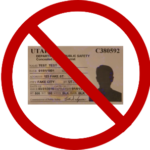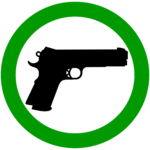
Constitutional Carry
If you are at least 21 years old and not a prohibited person as defined in 76-10-503 or 18 U.S.C. 922(g):
- It is LEGAL to carry any lawfully owned firearm fully loaded and concealed without a concealed firearm permit. No law requires the firearm to be concealed.
- It is ILLEGAL to have any firearm in State Prohibited Areas, or Federal Prohibited Areas.
- It is ILLEGAL to carry a firearm on any school premises unless you have a valid Utah concealed firearm permit.
- It is ILLEGAL to have a loaded rifle, shotgun, or muzzle-loading rifle in a vehicle unless you have a valid concealed firearm permit and it is your vehicle or you have consent from the owner of the vehicle. This means you can only have a loaded handgun in a vehicle.
See all other Constitutional Carry States.

Open Carry
This section only applies if you are 18 to 20 years old, not a prohibited person as defined in 76-10-503 or 18 U.S.C. 922(g) and you do not have a valid provisional concealed firearm permit:
-
- It is LEGAL to open carry (visible at all times) any lawfully owned firearm unloaded in public. See the law 76-10-502 and an explanation below.
- It is LEGAL to carry any lawfully owned firearm loaded and concealed;
- In your home including any temporary residence (hotel) or camp (including the tent) and on your real property.
- In your vehicle or a vehicle with the owner’s consent. Handguns ONLY
- In your business or business under your control. This can be explained as the possession, direct or indirect, of the power to direct or cause the direction of the management and policies of a person, whether through the ownership of voting securities, by contract, or otherwise. A member of an organization or an employee of a company who has significant sway in the decision-making process.
- While hunting as long as you are not within the limits of a municipality (city) and not on any highway (road).
- On duty as an armed security officer with a valid armed private security officer license.
Laws
76-10-500. Uniform law.
(1) As used in this section:
(a) "Directive" means the same as that term is defined in Section 78B-6-2301.
(b) "Firearm" means the same as that term is defined in Section 53-5a-102.
(c) "Local or state governmental entity" means the same as that term is defined in Section 78B-6-2301.
(2) The individual right to keep and bear arms being a constitutionally protected right under Article I, Section 6, of the Utah Constitution and the Second Amendment to the United States Constitution, the Legislature finds the need to provide uniform civil and criminal laws throughout the state and declares that the Legislature occupies the whole field of state regulation of firearms.
(3) Except as specifically provided by state law, a local or state governmental entity may not:
(a) prohibit an individual from owning, possessing, purchasing, selling, transferring, transporting, or keeping any firearm at the individual's place of residence, property, business, or in any vehicle lawfully in the individual's possession or lawfully under the individual's control; or
(b) require an individual to have a permit or license to purchase, own, possess, transport, or keep a firearm.
(4) This part is uniformly applicable throughout this state and in all the state's political subdivisions.
(5) Authority to regulate firearms is reserved to the state except where the Legislature specifically delegates responsibility to local or state governmental entities.
(6) Unless specifically authorized by the Legislature by statute, a local or state governmental entity may not enact or enforce a directive pertaining to firearms that in any way inhibits or restricts the possession, ownership, purchase, sale, transfer, transport, or use of firearms on either public or private property.
(7) This part does not restrict or expand private property rights.
(8) A violation of this section is subject to Title 78B, Chapter 6, Part 23, Firearm Preemption Enforcement Act.
- Semi-Automatic:
- A loaded magazine in the firearm, no round in the firing position (chamber is empty).
- Must have two mechanical actions to fire;
a. Rack the slide to load a round from the magazine into the chamber.
b. Press the trigger to fire the round. A “thumb”, “grip”, “trigger” or any other type of safety feature is not considered a mechanical action.
- Double Action Revolver:
- Ammunition can be loaded in the chambers of the cylinder, with no round in the firing position. This means the chamber behind the barrel must be empty. The next chamber must also be empty. Ensure you know in which direction the cylinder rotates (clockwise to the right, counterclockwise to the left).
- Must have two mechanical actions to fire;
1. Pressing the trigger once will rotate the cylinder with the empty chamber and place another empty chamber in line with the barrel.
2. Pressing the trigger a second time will rotate the cylinder, position a loaded chamber in line with the barrel, and fire the round.
